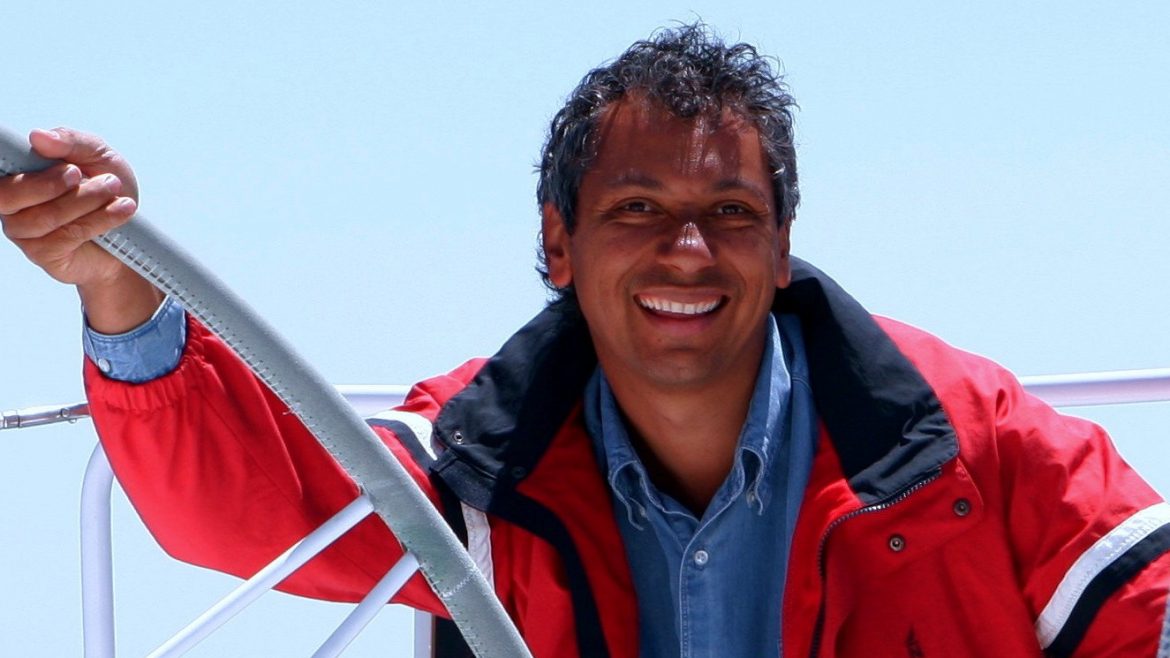No barriers. That is the theme of Neal Petersen’s life. It is one thing to adopt such a philosophy based on theory, quite another to live it by overcoming barrier after barrier.
Petersen was born with no left hip socket, had no money to begin a sailing career and was black in South Africa under the apartheid regime. Yet despite these disadvantages, he became the first black sailor to race solo around the world.
Petersen, 38, who now lives in South Carolina, is a dynamic speaker. His autobiography, “Journey of a Hope Merchant,” features both heartbreaking tales of tribulations and dramatic stories of seagoing adventures.
An engaging man, Petersen talked of being discouraged as a teenager by those who thought he didn’t belong in a sailboat and how the government sanctioned disapproval of any black man seeking to get ahead.
His is an unlikely success story, truly an against-the-odds journey. As a youth, Petersen endured three operations to improve his hip, then spent five months in a cast that stretched from his ankle to his chest. He couldn’t lie down and essentially lived propped up in a box.
Depressed in the hospital, his life was altered when given sailing magazines. Reading them planted the determination to become a solo sailor.
“I was at a very impressionable age,” Petersen said. “The pretty pictures stayed with me forever.”
When he was more mobile, Petersen hung out in a treehouse reading sailing literature, most notably Joshua Slocum’s “Sailing Alone Around the World,” and imagined battling giant waves and fearsome storms.
Petersen grew up near Cape Town. Undeterred by the racial climate and class differences, Petersen went slip to slip asking captains to let him sail. He might have been turned away 50 times for each acceptance, but those sails gave him experience. His skills improved and his popularity grew when skippers needed racing assistance.
“I got an incredible education,” Petersen said.
And he doesn’t mean just sailing. Petersen worked for hot-shot businessmen and listened when they discussed big-bucks deals. Years later, when he had the opportunity, he applied the lessons and made money. That was years in the future, well before Petersen commanded thousands of dollars per speech or wrote a book provoking 1,000 business executives per event to ask for signatures.
For a time, Petersen settled in Ireland, where children prompted creation of a Pennies for Petersen fund. He spoke to thousands of schoolchildren, urging them to follow their dreams. When Petersen built his own sailboat with an eye toward long-distance racing, it sorely lacked modern technology. “I was equipped little better than Joshua Slocum in 1895, or, for that matter, Columbus,” he wrote.
“Columbus had a few more luxuries,” Petersen joked later.
Critics ridiculed the 38-foot boat as “a floating coffin.” Completing the OSTAR race, successfully navigating from England to Newport, R.I., made his point. In a surprise gesture, officials awarded Petersen the key to the city for his inspirational finish.
By 1994, despite maxed-out credit cards, scrounging for sponsors and doubters galore, Petersen entered the BOC Challenge, a 27,000-mile sailboat race around the world. He figured his homemade boat was the equivalent of a Volkswagen Beetle going up against Ferraris.
Among those supporting Petersen’s efforts were friend Bill Pinkney, 69, the Chicago sailor who in 1992 became the first black man to sail solo around the world.
Petersen met Pinkney when the older man docked in South Africa on his solo sail and stayed at his mother’s house. He calls Pinkney his hero.
“He’s as nuts as I am,” said Pinkney, now living in Connecticut. “I was seeing Neal do the whole thing, and he had no angel coming down and saying, `You’re blessed.’ And he just kept going.”
Petersen finished the BOC race in 1995 and settled near Charleston, S.C., where he again lectures thousands of schoolchildren and where he met his wife, Darlene Kristi-Petersen.
Petersen is a compelling speaker with props like a rusted treasure chest that contains his old Slocum book and a worn sailing jacket. He calls it his only baggage.
Petersen circled the globe again in the 1999 Around Alone race. Someday, after raising the millions of dollars necessary, he plans to compete in the Vendee Globe, the non-stop race around the world, in style.
In the meantime, his wife, a novice sailor, has adapted well to shorter ocean forays.
“I’ll sail anywhere, anytime, anyplace with Neal,” she said. “I have a lot to learn.”
The brotherhood of solo circumnavigators is a small one. By some estimates, the feat has been accomplished only 300 times.
“When we’re out there, there’s no Coast Guard, there’s no search and rescue,” Pinkney said. “We’ve bonded.”
For all of his earlier hardships, Petersen emerged with an upbeat attitude.
“We are a unique family,” Petersen said of solo sailors. “And we are a family.”
Once frequently rejected by skeptics in his sport, Neal Petersen had the heart, outlook and dreams and proved bigger than them all.
———-
lfreedman@tribune.com


